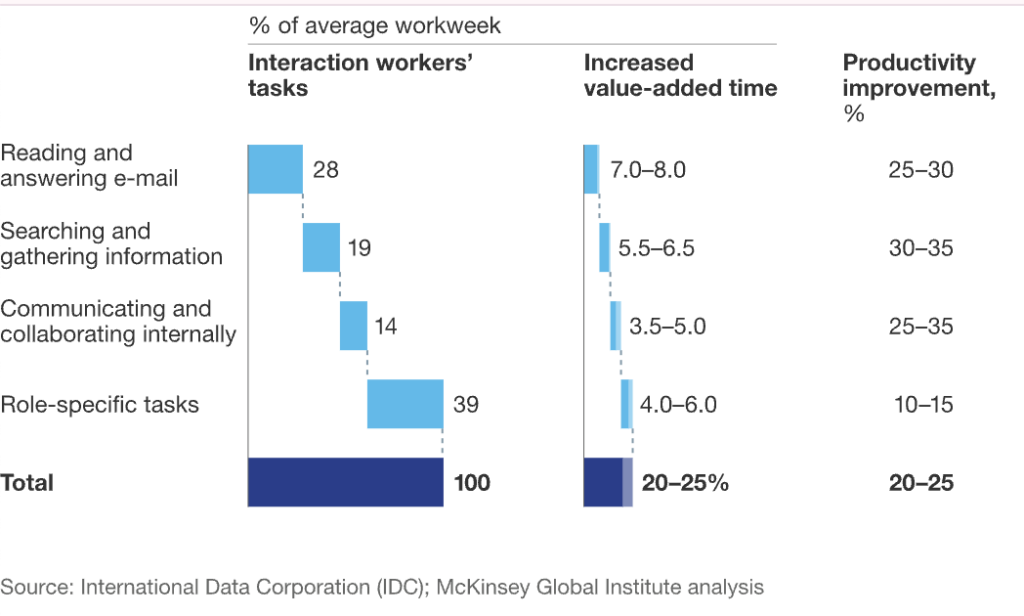Leading search engines such as Google or Bing have transformed our expectations of what search should be. Users now want faster searches, smarter recommendations, detailed personalization, and more, no matter where they’re searching from.
Employees expect the exact same thing. Companies spend substantial resources developing and managing product knowledge, including technical documentation, training materials, or even marketing collaterals. Unfortunately, this information is frequently dispersed across various repositories, which complicates the process for employees and users to locate the necessary resources when needed, leaving them feeling frustrated, unengaged, and unproductive.
Enterprise search software has become crucial to improve the ability of employees within an organization to efficiently locate information and be more productive.
Let’s explore what enterprise search software is, how it works, its benefits, use cases, and even features.
Enterprise Search Software Definition
An enterprise search software is a search tool designed to help users query an organization’s knowledge repository to find answers. This system aggregates extensive datasets in diverse formats from multiple sources.
It can take the form of a search bar that helps them explore your website’s content or it can be for internal use by your team, allowing them to find business info, documents, and everything about the company.
With the rise of AI, modern enterprise search software now uses machine learning (ML) and natural language processing (NLP) to provide organizations with deeper insights and deliver a more dynamic experience for employees.
How Does an Enterprise Search Software Work?
Enterprise search is like a smart detective that searches thoroughly through a ton of data sources in a company, like a website, knowledge base, intranet, and help center.
The whole process is split into three key steps to make sure information gets to the right people smoothly:
1. Exploration
During the exploration or collection phase, an enterprise search engine uses a crawling robot to browse through websites and directories to find data. This robot then gathers the data so it can organize and index the information for easy searching later on.
2. Indexing
After the enterprise crawling robot gathers the information, it organizes it into indexes. This categorization makes it simple to locate the data whenever you search for something. In addition to sorting, the process also includes extracting metadata and automatically summarizing content, which improves search accuracy and relevance.
You can also configure this process using APIs or connectors. These tools streamline the synchronization of data from its source to the platform, optimizing data accessibility and usability.
3. Querying
Once data is indexed, it becomes accessible for users to search. As a result, when a query is made, the search engine scans through its indexes to find relevant matches.
Employees can therefore find information, files, and documents, receiving results tailored to their access rights.
Existing Types of Enterprise Search
There are four types of Enterprise Search:
Siloed Search
Siloed search means that search functions are limited to separate databases or data sources within an organization. Each database or source works on its own without being connected or synchronized with others. This type of search leads to inconsistent results and low findability.
Federated Search
Federated search lets users search across many different sources of information all at once. Instead of searching each database one by one like in siloed search, federated search pulls together results from multiple places and shows them in a single view.
This makes it easier to find a wide range of information quickly and efficiently, without having to go to each source separately. It keeps each database independent but still gives you a complete picture without compromising the integrity of each source. However, performance can be slower due to the need to query multiple systems in real time.
Unified Search
A unified search involves consolidating all data into a single, centralized search index. Queries are executed against this unified index, and the results are typically ranked and displayed using a single relevance algorithm.
Unified search is generally faster as it queries a single index (vs multiple ones in a federated search.)
AI-Powered Search
AI-powered search brings together aspects of keyword and semantic searches using advanced AI technologies like NLP, ML, and deep learning. Unlike traditional search, it shows the underlying intent and context of a query, offering more personalized and relevant results.
Benefits of Using
Enterprise Search Software
Using an enterprise search software offers numerous benefits that empower organizations to leverage their knowledge more effectively.
Boost Productivity
According to research by SearchYourCloud, workers in the U.K. and U.S. spend an average of 25 minutes searching for a single document in more than a third of their searches. This is a massive cost for the company and dramatically reduces the overall productivity.
Having an effective enterprise search software could lead to a 30% productivity improvement as it helps users quickly find the information they need for their daily work. It also gives them the opportunity to be more autonomous.

Improved Customer Experience
Enterprise search enhances the experience for both customers and employees by allowing them to access content more intuitively in any customer-facing apps. On top of that, by getting tailored search results to their individual profiles and past interactions, customers receive information that is most relevant to their needs.
This leads to quicker problem resolution, reduced support burdens, and a more positive overall customer experience.
Ensured Compliance and Security
Enterprise search software helps organizations comply with regulatory requirements by controlling who can access information. Administrators can set permissions on a document level to ensure only authorized personnel see certain data.
Additionally, this technology facilitates compliance by enabling quick access to necessary information for audits and regulatory reporting, ensuring that organizations meet legal requirements.
Cost Efficiency and ROI
An enterprise search software represents a strategic investment for a company. It reduces operational inefficiencies by making it easier for anyone to find information.
By allowing customers and employees to find solutions on their own, the software reduces the need for costly support services. This results in substantial savings and increases ROI by making better use of existing data and improving how the organization functions overall.
Enterprise Search Software Features
Enterprise search technology differs among vendors, yet there is a minimum requirement when it comes to features.
Connectors and Integrations
One of the great things about enterprise search is its capability to gather information from various data sources. However, if your platform doesn’t support extensive data integration, you might not be able to connect your organization’s preferred CRM such as Salesforce or CMS, which could hinder your ability to provide seamless omnichannel interactions.
Access controls
For enterprise search software to deliver significant business benefits, it must feature a rigorous access control framework. This ensures that sensitive data remains secure and inaccessible to unauthorized personnel.
Moreover, robust permission controls enable personalized user experiences by tailoring search results based on factors such as role, product, country, or any other metadata that you can think of.
Security and Privacy
Considering the extensive data access capabilities of enterprise search tools, it is imperative for the software to incorporate leading security technologies and modern open standards such as ISO 27001 to provide users with the confidence that their data and analyses are secure.
Artificial Intelligence
AI has made search engines smarter, so they can understand what you’re looking for, why you’re searching, and learn from how you interact with them leading to a more intuitive, efficient, and personalized search experience. These capabilities are no longer a “nice to have” in enterprise search software.
Use Cases of Enterprise Search Software
Customer Self-Service
Customer self-service involves providing customers with the tools to independently resolve their issues, eliminating the need for direct interaction with the support team. It comes in many forms – chatbots, help desk, customer portals. In these tools, customers can access a searchable, centralized source of truth to find answers to their questions.
Furthermore, the integration of Generative AI with enterprise search can significantly enhance both customer self-service and agent support. It provides faster, more precise answers and recommendations, automatically generated based on a company’s data and past customer interactions.
Customer Support
A high-performing enterprise search engine is crucial for optimizing customer support operations by facilitating seamless access to comprehensive knowledge bases. Customer support representatives can use the enterprise search engine to swiftly retrieve pertinent information, enabling them to efficiently resolve inquiries and expedite issue resolution.
Effective management and tracking of support cases are also essential in customer support ecosystems. Enterprise search technology enhances this process by retrieving case-specific data, ensuring that support agents have immediate access to essential details.
Employee Onboarding and Training
Enterprise search software simplifies employee onboarding and training by offering a central access for all company resources, policies, and documents.
New hires can easily find training materials, procedural guides, and company handbooks through a user-friendly search interface, saving time otherwise spent navigating different systems. With advanced features like NLP and ML, the software delivers accurate, relevant search results. It also indexes and cross-references multimedia content such as training videos and interactive modules, creating a comprehensive, self-service learning environment.
By integrating with HR and knowledge management systems, enterprise search ensures smooth information flow, real-time updates, and consistent training content, speeding up onboarding and promoting continuous learning and development.
Fluid Topics AI-Powered Search
Fluid Topics’ AI-powered Content Delivery Platform leveraged over two decades of research and development in AI and NLP to develop its semantic search capabilities based on embeddings. Our proprietary AI-driven search technology provides superior relevance out of the box. It supercharges our CDP with unique customization and personalization capabilities and prioritizes results based on relevance, context, and user behavior, enabling faster and more efficient access to knowledge.
Additionally, our platform now incorporates Retrieval Augmented Generation (RAG) into its framework. RAG is a technique that enhances the response capabilities of a Large Language Model (LLM). It does this by retrieving and dynamically injecting fresh, trusted data from a company’s own knowledge base and enterprise systems into the LLM. While RAG enriches the language model’s output with up-to-date information, semantic search focuses on pinpointing the data that is most relevant to the context of the user and their credentials. Fluid Topics’ search technology combines both functionalities to create the ultimate synergy resulting in unmatched accuracy in AI-driven responses.
The Future of Search is
Semantic and Conversational
AI becoming more prominent in search technology has caused a big change in how people search, moving away from just using keywords to asking full questions in their searches. As a result, search engines will become more like talking to a helpful friend.
Conversational search lets you ask questions in everyday language, making searching easier for everyone, especially those not used to typing exact phrases. The blend of conversational and semantic search is creating a future where search engines don’t just find information—they understand and meet your specific needs whether you’re using a phone, smart speaker, or any other device.
With advances in AI and machine learning, search engines will even get better at understanding what you need and adapting to your preferences over time.
At Fluid Topics, we know that Generative AI technologies like ChatGPT will impact product knowledge and documentation. Leveraging advanced AI capabilities, we are actively enhancing our search and discovery functionalities to deliver more robust and intuitive tools for all users.
Latest post





